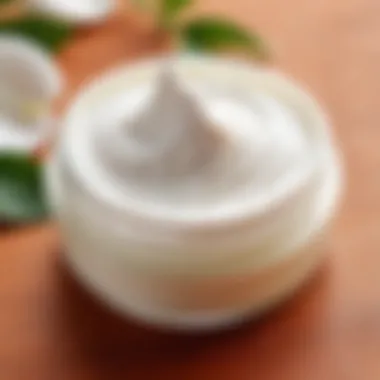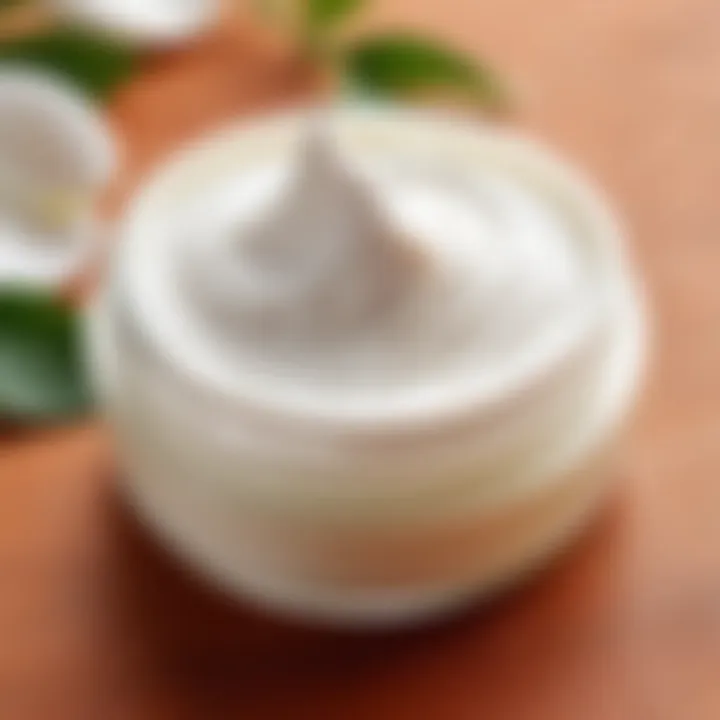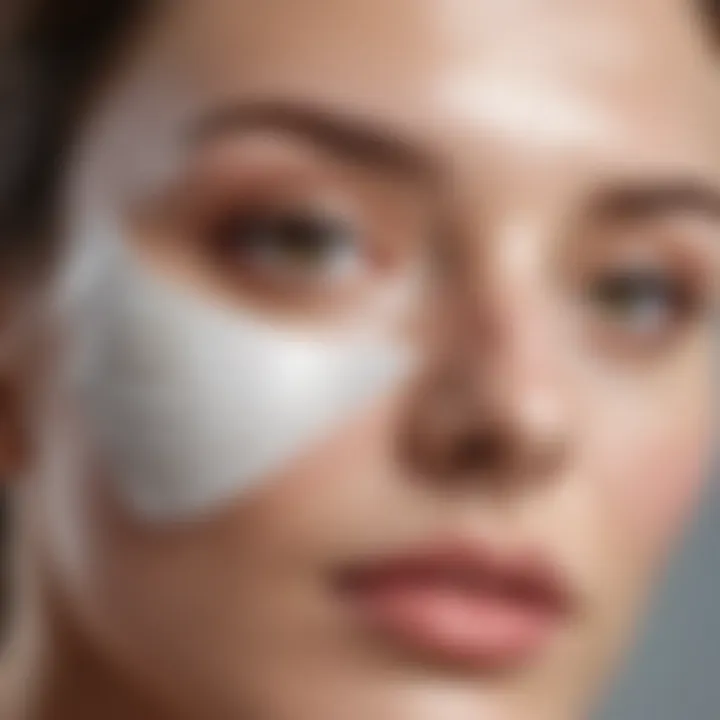Revitalize Your Skin: Homemade Masks for Dry Skin


Intro
Dry skin is a common concern for many, affecting individuals of all ages. It can lead to discomfort, irritation, and a dull appearance. Understanding the causes of dry skin is essential for effective treatment. Factors such as environmental conditions, lack of moisture, and certain skincare products can contribute to dryness. Homemade masks provide a simple solution, using accessible ingredients to hydrate and nourish the skin.
This article will explore various homemade masks tailored specifically for dry skin. We will examine the benefits of natural ingredients and present easy-to-follow recipes. Through this guidance, individuals can create a personalized skincare routine that not only addresses dryness but also promotes overall skin health.
Ürün İncelemesi
Ürün Tanıtımı
Homemade masks are an effective blend of natural ingredients that cater to the unique needs of dry skin. Unlike commercial masks, these homemade versions allow full control over each ingredient, ensuring they are free from harmful chemicals. Common components include honey, yogurt, and avocado, all known for their moisturizing properties.
Ürün Özellikleri
- Honey: Known for its humectant properties, honey attracts moisture to the skin. It also has antibacterial qualities that support overall skin health.
- Yogurt: Rich in lactic acid, yogurt gently exfoliates and hydrates the skin, helping to create a smooth surface. It also has a cooling effect, making it ideal for irritated skin.
- Avocado: Full of healthy fats and vitamins, avocado provides deep nourishment. It helps to restore elasticity and reduce the appearance of fine lines.
By combining these ingredients, individuals can create a revitalizing mask that targets dryness effectively.
Güzellik İpuçları
Doğal Güzellik Yöntemleri
Using natural ingredients comes with numerous advantages. They tend to be more gentle on the skin, reducing the risk of allergic reactions. Some tried-and-true methods include:
- Oatmeal Mask: Mix ground oatmeal with water to form a paste. Apply for soothing relief.
- Coconut Oil: This oil can be used as a pre-mask treatment, offering hydration before applying the main mask.
- Banana and Olive Oil: Mash a ripe banana and combine with olive oil for a creamy, nourishing mask.
Sağlıklı Beslenme ve Güzellik
A well-balanced diet also supports skin health. Consuming foods rich in omega-3 fatty acids, vitamins A, C, and E can help maintain skin hydration from the inside out. Hydration is key, so drink plenty of water throughout the day.
"Your skin reflects your overall health. Nourish it well!"
Prolusion to Dry Skin
Dry skin is not merely a cosmetic concern but a condition that demands attention and understanding. It is a prevalent issue that can impact individuals of various ages. Our skin, the body's largest organ, serves as a barrier that protects us from external elements. When it becomes dry, this barrier is compromised, leading to discomfort and potential complications. Therefore, it is crucial to recognize and address dry skin. Applying the right skincare practices can enhance the overall health of the skin.
Understanding Dry Skin
Dry skin, or xerosis, occurs when the skin loses its natural moisture. This can manifest as flakiness, itching, or a rough texture. In severe cases, the skin may crack, making it susceptible to infections. Variations in skin type play a role, as some individuals have naturally drier skin than others. Environmental factors, such as low humidity or excessive sun exposure, can exacerbate this condition.
Common Causes of Dry Skin
Several factors contribute to dry skin, including:
- Weather Conditions: Cold or windy weather can strip moisture from the skin.
- Hot Showers or Baths: Prolonged exposure to hot water can weaken the skin's barrier function.
- Harsh Soaps and Products: Certain soaps contain ingredients that can irritate or dry out the skin.
- Aging: As individuals age, the skin produces less oil, contributing to dryness.
Impact on Personal Care
The effects of dry skin extend beyond mere appearance. Individuals may find it challenging to use makeup or skincare products, as dryness can interfere with application. Furthermore, dried-out skin can lead to more serious issues such as eczema or other dermatological conditions. This makes it crucial for skincare routines to include effective methods to combat dryness, such as hydration masks and other treatments. By understanding dry skin, you are better equipped to manage it effectively.
The Need for Hydration
Hydration is essential for healthy skin. Skin serves as a protective barrier, and when it lacks moisture, it becomes vulnerable to various problems. Dry skin can lead to discomfort and more serious dermatological issues over time. This section emphasizes the significance of hydration in skincare. A well-hydrated complexion not only appears radiant but also functions effectively in protecting against environmental aggressors.
Why Hydration Matters
Skin cells depend on water to maintain their structure and function. Hydrated skin exhibits elasticity and resilience. When water levels are adequate, skin feels smooth and supple. Conversely, dehydration can cause flakiness, irritation, or tightness.
Moreover, hydration supports the skin's ability to repair itself. Dry skin becomes a breeding ground for irritations and may lead to premature aging. Adequate moisture contributes directly to a youthful appearance by minimizing the visibility of fine lines and wrinkles. Therefore, understanding the importance of hydration is crucial for a beneficial skincare routine.


Signs of Dehydrated Skin
Dehydrated skin often displays several noticeable signs. Recognizing these indicators can prompt effective intervention. Here are common symptoms of dehydrated skin:
- Tightness: A feeling of tightness or discomfort, especially after cleansing.
- Flakiness: The presence of dry patches or excessive flaking.
- Dullness: Skin appears less vibrant and lacks a natural glow.
- Fine Lines: Increased visibility of fine lines, particularly around the eyes and mouth.
- Itching or Irritation: An ongoing sensation of itchiness or irritation.
Proper hydration helps maintain the skin's barrier, reducing the likelihood of these unpleasant symptoms.
Taking note of these signs is the first step towards better skincare practices. Regularly applying hydrating masks can significantly improve the overall texture and appearance of dry skin.
Natural Ingredients for Dry Skin Masks
Benefits of Natural Ingredients
Natural ingredients are known for their numerous benefits compared to chemical alternatives. Some key points to consider include:
- Gentleness on the Skin: They are less likely to cause irritation, making them suitable even for sensitive skin types.
- Nutrient Density: Natural ingredients often contain vitamins, minerals, and antioxidants that nourish the skin.
- Restore Balance: These elements can help maintain skin's natural oils and moisture balance.
- Eco-Friendly: They contribute to sustainability by reducing reliance on non-renewable resources.
Using natural ingredients fosters a deeper connection to self-care routines, allowing the user to take a more informed and personalized approach.
Honey as a Moisturizer
Honey is a powerful moisturizing agent known for its humectant properties. This means it can attract moisture from the atmosphere into the skin. Honey also has antibacterial and anti-inflammatory qualities.
- How it Works: Honey penetrates deeply into the skin, providing lasting hydration. It can also promote repair for dry and flaky skin.
- Usage: Applying honey directly or mixing it into masks can enhance the moisture content significantly, particularly beneficial in dry climates.
When combined with other nourishing components in a homemade mask, honey becomes a star ingredient, enhancing hydration and promoting healthy skin.
Aloe Vera and Its Soothing Properties
Aloe Vera is celebrated for its soothing and healing properties. It is rich in vitamins and contains enzymes that aid in skin regeneration.
- Skin Benefits: Aloe Vera can calm irritation, reduce redness, and provide moisture simultaneously. It is especially useful after sun exposure or when skin feels stressed.
- Formulation: The gel from the plant can be easily extracted and used directly on the skin or included in various masks, increasing their effectiveness.
Aloe Vera can be paired with other hydrating agents to amplify its natural abilities, thus creating an effective remedy for dry skin.
Oils: Coconut, Olive, and Avocado
Oils are another category of natural ingredients that offer extensive benefits for dry skin. Each oil brings unique properties:
- Coconut Oil: Known for its rich fatty acids, it deeply hydrates and acts as a barrier to retain skin moisture. It also possesses antimicrobial properties.
- Olive Oil: A powerful antioxidant, olive oil helps protect the skin from aging. Its emollient characteristics make it effective for smoothing and softening skin texture.
- Avocado Oil: This oil is filled with vitamins A, D, and E, making it excellent for rejuvenation. It penetrates the skin well, providing nourishment at deeper levels.
Using a blend of these oils can create a synergistic effect, contributing to enhanced hydration, smoothness, and overall skin health.
Homemade Mask Recipes
Homemade mask recipes offer a valuable solution for dealing with dry skin. They allow individuals to utilize natural ingredients that are often found in the kitchen. This not only saves money but also ensures that users avoid harsh chemicals found in commercial products. In this section, we explore several effective homemade masks designed to provide moisture and essential nutrients to dry skin, helping to restore its natural glow and texture.
Basic Hydrating Mask
Ingredients List
A basic hydrating mask typically includes simple, yet effective ingredients like honey, yogurt, and olive oil. The unique combination of these ingredients is beneficial because each serves a specific purpose. Honey acts as a natural humectant, drawing moisture into the skin. Yogurt contains lactic acid, providing gentle exfoliation and promoting a smoother appearance. Olive oil is rich in healthy fatty acids, which nourish and hydrate the skin.
The simplicity of the ingredients list makes it accessible. One can easily find these in any kitchen. This mask is popular due to its effectiveness and ease of preparation, appealing to those looking for quick relief from dryness. However, it is essential to ensure no allergies to any ingredients before applying the mask.
Preparation Method
To prepare this mask, follow a straightforward method. Start by mixing one tablespoon of honey with two tablespoons of yogurt and a tablespoon of olive oil until smooth. This method is practical for anyone, requiring minimal time and effort.
The key characteristic of this preparation method is its simplicity. It allows for quick assembly, making it a great choice for people with busy lifestyles. However, ensure all ingredients are combined well to maximize the benefits. This mask is easy to prepare but requires some care to mix ingredients thoroughly to avoid clumps.


Application Tips
When applying the mask, ensure the skin is clean and dry. Use gentle circular motions to spread the mixture evenly across the face. This method aids in better absorption of the nutrients. Allow the mask to sit for about 15-20 minutes before rinsing it off with lukewarm water.
The application tips emphasize the importance of preparation and careful application. A thorough cleansing of the skin beforehand will enhance the mask's effectiveness. Moreover, using gentle motions helps stimulate blood circulation. This process can enhance skin nourishment, providing additional rejuvenation for dry skin.
Banana and Honey Nourishing Mask
Ingredients List
The ingredients for the banana and honey nourishing mask include ripe bananas and honey. Bananas are packed with vitamins A, B, and E, beneficial for skin health. They provide hydration and elasticity, making them a favorable choice for moisturizing masks. Honey, as previously mentioned, adds its signature humectant properties. The combination creates a natural synergy that addresses dryness effectively.
This mask is popular due to its delicious scent and the ease in finding soft bananas. The unique feature here is the banana's creamy texture, which blends smoothly, allowing for easy application. However, ripe bananas must be used since unripe bananas may lack the required moisture content.
Preparation Method
To create this mask, mash one ripe banana in a bowl and mix in one tablespoon of honey until the mixture is smooth. This preparation method is simple, making it easy for anyone to replicate at home without complex techniques.
The ease of this preparation is a strong advantage. This mask can be prepared in minutes, meaning users can quickly implement it into their skincare routine. However, ensure the banana is fully ripe, as unripe bananas will not yield the desired creamy texture.
Application Tips
Apply the mask to clean skin using fingertips or a brush. Use upward strokes to apply evenly, helping to improve circulation while applying. Leave the mixture on the skin for 20 minutes before rinsing with cool water.
The focus on application here is crucial; clean skin maximizes mask efficacy. The upward strokes during application can also promote a natural lift to the appearance of the skin. It allows for thorough absorption of nutrients while being mindful of skin health principles.
Yogurt and Avocado Revitalizing Mask
Ingredients List
The yogurt and avocado revitalizing mask consists of plain yogurt and ripe avocado. Avocado is well known for its richness in vitamins and healthy fats, which offer intense moisture. Meanwhile, yogurt contains beneficial probiotics and lactic acid, which can help improve skin texture and tone.
The key characteristic of this ingredient list is the combination of rich, nourishing properties that both ingredients provide. Avocado gives deep hydration, while yogurt acts as a gentle exfoliant. This mask is popular among those seeking a natural and nutrient-dense skincare option. Yet, avocado that is not ripe enough will not blend well, creating a challenge during preparation.
Preparation Method
Prepare the mask by mashing half a ripe avocado with two tablespoons of yogurt until it reaches a smooth consistency. This method is quick, making it ideal for those who need results without fuss.
The major advantage of this preparation method lies in its straightforwardness; it is uncomplicated and can be completed in under five minutes. However, ensure the avocado is ripe to achieve the creamy texture necessary for effective application.
Application Tips
Spread the mask over clean skin, ensuring an even application. Let it remain on your face for 15-20 minutes, then rinse with lukewarm water. Using a warm towel before applying can help open up pores, enhancing absorption.
Highlighting the application method in this mask brings attention to the impact of warm towels. Open pores allow the nourishing properties of avocado and yogurt to penetrate deeper, promoting better results. This consideration can significantly improve how effective the mask is for revitalizing dry skin.
Oatmeal and Aloe Vera Soothing Mask
Ingredients List
This mask incorporates rolled oats and fresh aloe vera gel. Oatmeal is widely recognized for its soothing properties and is effective for various skin irritations. Aloe vera is well known for its moisturizing and healing abilities. The combination acts powerfully against dryness and discomfort.
The unique characteristic of this ingredients list is its dual action; oatmeal calms the skin while aloe vera hydrates it. This mask becomes a go-to choice for people experiencing sensitivity and dryness. However, it's crucial to ensure that the aloe vera used is fresh to receive maximum benefits.
Preparation Method
Prepare the mask by blending two tablespoons of rolled oats with two tablespoons of aloe vera gel until it forms a paste. This method is simple yet requires a blender or food processor to achieve the right texture.
The ease of this method makes it a favorable option. However, not having the right tools could result in uneven texture. Hence, it is advisable to ensure that there is access to blending equipment to achieve the desired results.


Application Tips
Apply the mask on clean skin, focusing on dry areas. Leave it for about 20 minutes and rinse with cool water. Applying the mask while lying down can prevent it from dripping and make the process more enjoyable.
Focusing on application technique emphasizes the importance of comfort during the process. Lying down not only makes the experience soothing but also helps to keep the mask in place. By paying attention to comfort, users are more likely to enjoy mask application and adhere to a regular skincare routine.
Application and Frequency
How to Apply Face Masks Correctly
Applying a mask properly maximizes benefits while minimizing any potential irritation. Follow these steps for optimal results:
- Cleanse Your Face: Start with a gentle cleanser to remove dirt and impurities. This prepares the skin for better absorption of the mask's ingredients.
- Use a Suitable Tool: For applying the mask, consider using a clean brush or your fingers. A brush can provide a more even application, while fingers allow for better targeting of areas needing more attention.
- Apply Evenly: Spread the mask evenly across your face while avoiding sensitive areas such as the eyes and mouth. Ensure that the layer is neither too thick nor too thin, as this can influence the efficacy.
- Leave on for Appropriate Time: Follow specific instructions for the mask you use. Most masks perform best when left on for 10 to 20 minutes, but it’s essential to consult each recipe.
- Rinse Thoroughly: After the designated time, rinse off the mask with lukewarm water. Pat dry gently with a clean towel.
- Moisturize: After masking, use a suitable moisturizer to lock in the hydration. This step reinforces the benefits of the mask and helps create a protective barrier.
Proper application not only enhances the effectiveness of the mask but also provides a pleasurable and rejuvenating experience.
Recommended Frequency of Use
Frequency of use largely depends on the mask’s ingredients and your skin’s condition. Generally, it’s advisable to mask once or twice a week to maintain hydrated skin without overwhelming it with product application. Consider these guidelines:
- Hydrating Masks: For masks that focus predominantly on hydration, once or twice a week is sufficient.
- Exfoliating Masks: If your mask contains exfoliating ingredients like oats or fruits, limit these to once a week to avoid irritation.
- Listen to Your Skin: Pay attention to how your skin responds post-application. If irritation occurs, reduce your usage frequency or consult with a dermatologist.
Balancing the application and frequency of your mask routine ensures that your skin reaps the beneficial effects without the risk of adverse reactions.
Taking care of your skin is an ongoing journey. By applying your masks correctly and choosing an appropriate frequency, you cultivate healthier and more resilient skin over time.
Maintaining Skin Hydration
Maintaining skin hydration is crucial for overall skin health, especially for those who deal with dry skin. Proper hydration not only helps in improving the skin's appearance but also plays a role in its elasticity and resilience. Hydrated skin can better fend off environmental stressors, irritants, and signs of aging. When skin is well-hydrated, it appears plumper and more radiant, which can enhance one’s overall look.
Daily Skincare Routine for Dry Skin
A daily skincare routine specifically designed for dry skin can significantly enhance skin hydration. Here are some essential steps to consider:
- Cleansing: Use a gentle, hydrating cleanser that does not strip the skin of its natural oils. Look for products containing ingredients like glycerin or hyaluronic acid.
- Toning: Opt for an alcohol-free toner. This helps to balance the skin's pH levels while delivering hydration.
- Moisturizing: Choose a thick moisturizer, especially creams that include occlusive agents like shea butter or mineral oil. Apply it while the skin is still slightly damp for better absorption.
- Sun Protection: Daily sunscreen application is vital, regardless of the weather. This prevents further drying due to sun exposure.
It is also pertinent to include treatments. These may involve serums with hyaluronic acid or oils that can create an additional barrier against occlusive factors. Using these products consistently can soothe skin while preventing moisture from escaping.
Hydration Beyond Masks
While homemade masks are effective, hydration extends beyond them. Integrating hydration into overall skincare is vital.
- Diet: Consuming foods high in water content, like cucumber, watermelon, and citrus fruits can help. Hydrating foods contribute to your skin's moisture from the inside out.
- Water Intake: Drinking enough water daily cannot be overstated. It is widely recommended to aim for at least eight glasses per day, although individual needs may vary.
- Environment: Humidifiers can be useful in dry climates or during winter months to maintain moisture levels in the air, thus benefiting your skin.
- Limit Hot Showers: While hot showers can be relaxing, they can also strip the skin of its moisture. Opt for lukewarm water instead, and limit shower time.
Remember, maintaining good hydration is a multi-faceted approach. Consistency in skincare routines and lifestyle adjustments will yield the best results.
Final Thoughts
In the journey of caring for dry skin, it is essential to conclude with some important reflections. Homemade masks provide an effective and accessible way to address the challenges posed by dry skin. Not only do these masks contain natural ingredients that can hydrate and nourish, but they also encourage users to take an active role in their skincare routines. This promotes a greater understanding of personal skin needs and preferences.
Choosing the Right Approach
When selecting a homemade mask, considering your skin type and individual requirements is crucial. Each recipe utilizes distinct ingredients that bring unique properties to the skin. For instance, if you are particularly dry, oatmeal or avocado masks may provide the additional moisture needed. For sensitive skin, honey or aloe vera can offer soothing effects without irritation.
Here are some key points to consider when choosing the right approach:
- Assessing Ingredients: Understand what each ingredient offers. Honey is great for its antibacterial properties, while coconut oil acts as an effective barrier to retain moisture.
- Patch Testing: Before applying any mask, perform a patch test to check for potential allergic reactions. This step is important, especially for non-native ingredient users.
- Customizing Recipes: Don’t hesitate to mix and match ingredients based on your skin's changing needs. Variability can yield better results.
Encouraging Consistent Care
Consistency is key to achieving lasting results for dry skin. Regular application of homemade masks can gradually improve skin texture and moisture levels. However, it goes beyond the use of masks. A holistic approach to skincare involves:
- Daily Hydration: Drink adequate water throughout the day. This internal moisture supports skin health.
- Moisturizing Routine: Follow up with a good moisturizer after using masks. This helps to lock in the benefits.
- Balanced Diet: Incorporate foods rich in omega-3 fatty acids, vitamins, and minerals. These are fundamental to promoting skin health from within.
"Consistent care is more than just a routine; it is a commitment to your skin's health."
In summary, homemade masks serve as an excellent addition to any skincare regimen aimed at treating dry skin. When chosen and applied correctly, they provide benefits that can significantly enhance skin vitality. By fostering a consistent and informed approach to skin care, individuals can achieve smoother, healthier, and more hydrated skin.







